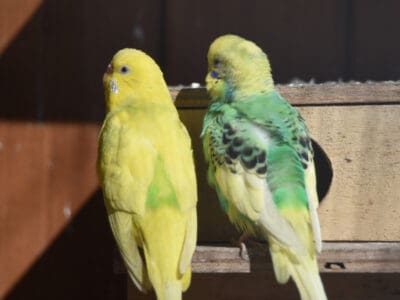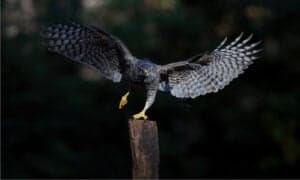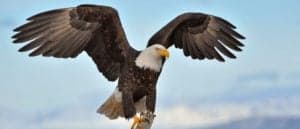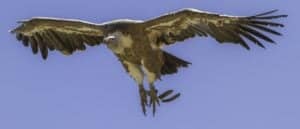7 Deadliest Birds On Earth
While the age of dinosaurs may be long gone, these majestic and terrifying creatures continue on today as various bird species. And while the typical cardinal or bluebird doesn’t pose the slightest threat to anyone, many birds are still living up to the legacy of their ancestors. Whether they stand at nine feet tall or less than nine inches, these are the seven deadliest birds on Earth.
#7: Australian Magpie: Australia’s Seasonal Threat
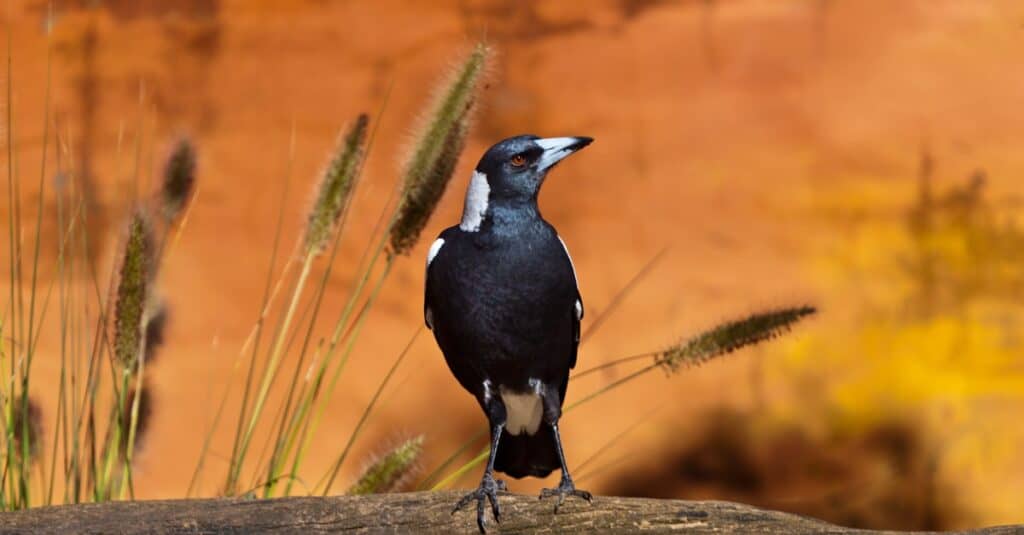
iStock.com/paulacobleigh
In August of 2021, a child in Brisbane, Australia was tragically killed by a swooping attack from a magpie — but this so-called “swooping season” is a common occurrence throughout this and many other urban areas in Australia. It’s a nuisance that many have just come to accept as part of their daily lives. The erratic flight patterns of these birds — which can target random people, pets, and even predators of the magpie — lead to thousands of injuries every year, and roughly one in five people who live in magpie territory during the swooping season will experience aggressive behavior from these deadliest birds on Earth.
But if it’s any small consolation, the behavior isn’t personal or even necessarily antagonistic. “Swooping season” occurs between July and November and coincides with the breeding season. This aggressive swooping behavior is employed by males of the species and is intended to protect their nests during the period where their eggs are being laid and then when the nestlings are being reared. Brisbane and other cities are tackling the challenging task of figuring out how to make sure these birds stay protected while also reducing the danger they pose to humans.
#6: Harpy Eagle: A Flying Killing Machine
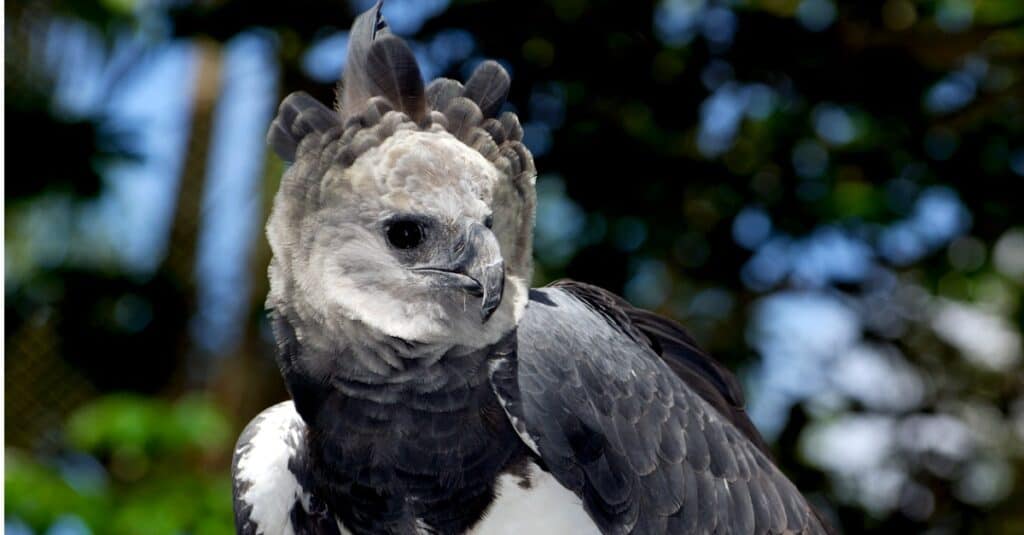
Alfredo Maiquez/Shutterstock.com
In the rainforests of South America, few predators are as feared or effective as the harpy eagle. As the largest eagle in the Americas, it has an impressive wingspan of six and a half feet, and they’re unafraid of hunting down prey as large as sloths and monkeys as a result. But size isn’t the only advantage of these raptors, as practically everything about them seems to have been evolved for the sake of turning them into the perfect predator.
The talons of the harpy eagle can extend to up to six inches — longer even than the average claw of a cassowary — and their hooked design allows them to grip and hold on to heavy prey while flying to their nests. Like most eagles, this species has especially good eyesight — but they also have small feathers on their face that help direct noise into their ears and provide them with a greater sense of directional hearing. Harpy eagles don’t pose a threat to humans, but humans undoubtedly pose a threat to them. Neither aggressive nor shy, they tend to treat humans indifferently — but that makes them easy targets for hunters.
#5: Lammergeier: Delivering Death From Above

Petr Salinger/Shutterstock.com
Lammergeier translates to “lamb vulture”, a reference to the fact that this enormous vulture was accused of flying off with both livestock and children in the sharp grip of their talons. And while their gruesome credentials may be hard to verify, we do know that the lammergeier is a scavenger. That means that all of their prey is already dead — but these unusual birds have no interest in typical flesh, instead of making a diet of bones. Small bones and shards of bones can be swallowed whole — and larger bones will be carried far into the air before dropping them, letting the rocks below expose the marrow that offers most of their nutritional content.
Whoa, be to anyone or anything standing beneath the rain of bones. And while raw bones would give most animals at least little indigestion, the lammergeier’s powerful stomach acids can easily break down the bone and extract the valuable nutrients from the marrow. And while there has been stories history about these birds murdering humans throughout history, there has not been a verified instance of death caused by this enormous bird.
#4: Ostrich: The Heavyweight Champ of the Bird World
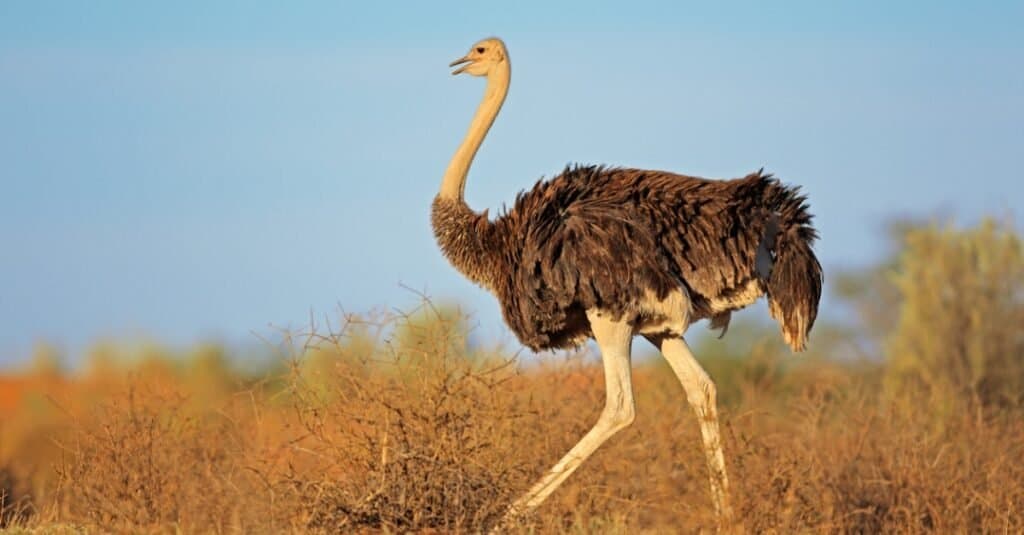
iStock.com/EcoPrint
Ostriches have a strong data point to support their argument as the deadliest birds on the planet — at least five confirmed human deaths. Similar in physiology to the Cassowary, these birds call Africa home, and their strong legs and six-inch talons can kill a lion, disembowel a human, or even puncture the frame of a car. Fortunately, while these birds can be lethal, they rarely attack unless they feel like they’re being threatened. Unfortunately, males tend to get very aggressive during mating season, and miscommunication has led to conflicts between humans and these birds in the past.
But even if they aren’t intent on hurting you, these dangerous birds are big enough to be terrifying. They’re the largest bird in the world, with the largest members of the species clocking in at over 300 pounds. Males can even reach a height exceeding nine feet. Practically half of that height is devoted to their awkward-looking necks. And while these birds may look gawky, they have the speed to back up that power. They can reach a top speed of over 40 miles per hour.
#3: Pitohui: The World’s Only Toxic Bird
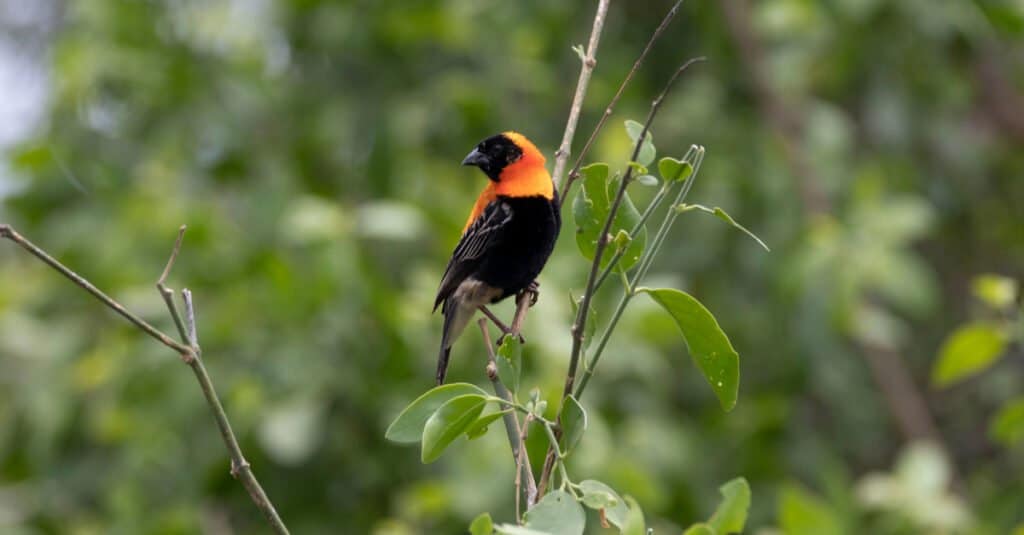
offitaly/Shutterstock.com
New Guinea‘s pitohui is the world’s only toxic bird, and, considering it’s one of the deadliest birds on Earth, that’s something we should probably all be grateful for. That’s because the toxin that their bodies produce — batrachotoxin — is the same employed by South America’s deadly poison dart frog. Even more frighteningly, this toxin is delivered in the same way — through simple touch. Locals know how to identify a pitouhi on sight alone, and they know to avoid them at all costs. It’s a quality that was first discovered by the scientific community when researchers inadvertently got the poison on their lips and felt them become numb — although exposure can certainly be fatal.
At the very least, the deadliest of the species are eager to telegraph that fact. Among the different pitohui species, the most dangerous has bright red and black plumage. But it’s believed that these birds don’t produce the toxin themselves. Instead, it enters their bodies thanks to the beetles that make up a significant part of their diets. Throughout generations, these birds have developed strong resistance to this toxin.
#2: Crowned Eagle: The Only Known Avian Man-Eater
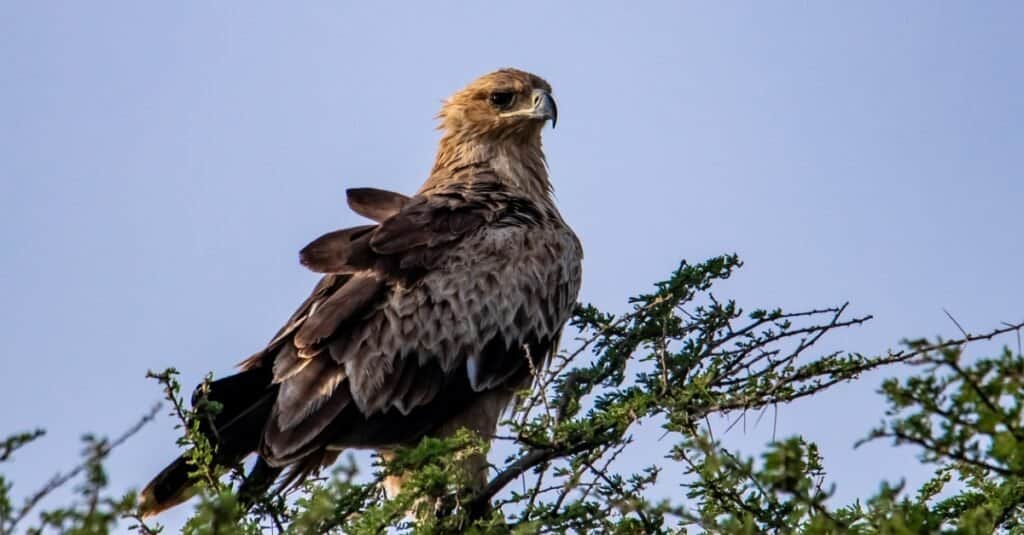
iStock.com/Miki Meller
Bird fatalities are rare, and even the most dangerous of birds rarely cause injuries unless they’re first provoked — but this deadliest bird on Earth known as the African crowned eagle could be the exception that proves the rule. Their claws are viciously designed to sink into prey like meat hooks and lurch back into the sky without even pausing, and that prey includes victims as large as monkeys and even potentially children. Remains of the bird found in 1924 were accompanied by the skull of a primitive human child, and it had talon markings consistent with the feeding patterns of the bird.
Even today, stories persist of this bold and relentless predator hunting human children for food. And as these hawks become a normal presence throughout South African cities, likely, these rumors will only grow. But if humans are prey, they aren’t common prey. They’re far more deadly to small mammals like mongooses and rats, though they can also make quick work of antelopes, whose skulls they can capably crush with their powerful claws.
#1: Southern Cassowary: The World’s Most Dangerous Bird
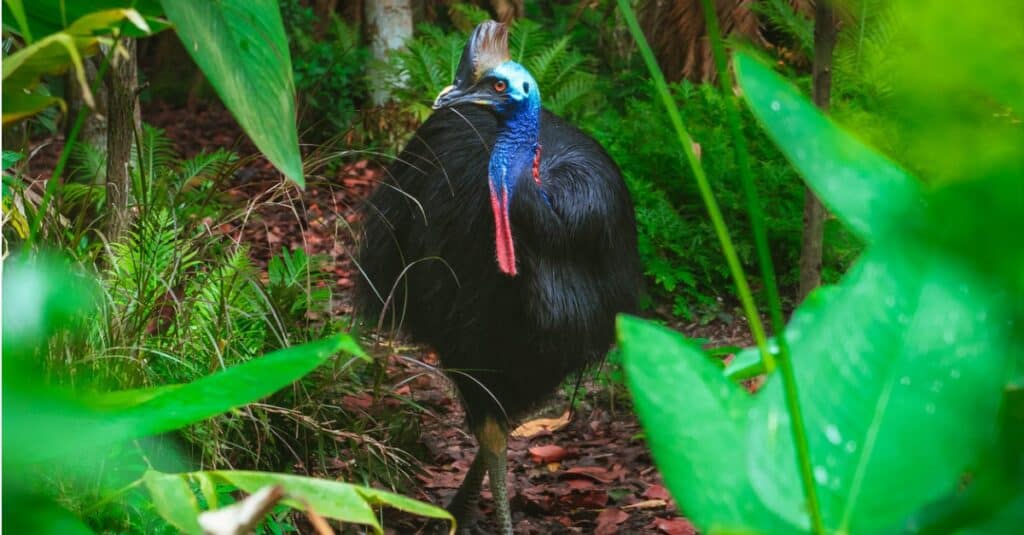
iStock.com/Henry Soon
While there are quite a few birds worth being a little afraid of, there’s little argument that the Southern Cassowary deserves the distinction of the most dangerous bird on Earth. Despite being concentrated exclusively in Australia and having population numbers that put them on the endangered species list, this deadliest bird on Earth has made hundreds of attacks on humans and at least one fatality associated with the Southern Cassowary. Most of these attacks were the result of humans trying to feed or otherwise interact with these large birds.
All you have to do is look at this bird to see why it’s so dangerous. Weighing in at 200 pounds and standing a full six feet tall, it’s one of the largest birds in existence. But its most dangerous characteristics are the three claws that grow from each foot — the longest of which is knife-like and extends to five inches. While these talons allow the cassowary to effectively run away from predators, they can also gut a human being with a simple slash. Despite being such dangerous birds, anthropological evidence indicates that they were domesticated by humans 18,000 years ago. That’s thousands of years before the chicken.
Next up: 10 Birds That Sing: The Most Beautiful Bird Songs in the World
More from A-Z Animals
While the age of dinosaurs may be long gone, these majestic and terrifying creatures continue on today as various bird species. And while the typical cardinal or bluebird doesn’t pose the slightest threat to anyone, many birds are still living up to the legacy of their ancestors. Whether they stand at nine feet tall or less than nine inches, these are the seven deadliest birds on Earth.
#7: Australian Magpie: Australia’s Seasonal Threat

iStock.com/paulacobleigh
In August of 2021, a child in Brisbane, Australia was tragically killed by a swooping attack from a magpie — but this so-called “swooping season” is a common occurrence throughout this and many other urban areas in Australia. It’s a nuisance that many have just come to accept as part of their daily lives. The erratic flight patterns of these birds — which can target random people, pets, and even predators of the magpie — lead to thousands of injuries every year, and roughly one in five people who live in magpie territory during the swooping season will experience aggressive behavior from these deadliest birds on Earth.
But if it’s any small consolation, the behavior isn’t personal or even necessarily antagonistic. “Swooping season” occurs between July and November and coincides with the breeding season. This aggressive swooping behavior is employed by males of the species and is intended to protect their nests during the period where their eggs are being laid and then when the nestlings are being reared. Brisbane and other cities are tackling the challenging task of figuring out how to make sure these birds stay protected while also reducing the danger they pose to humans.
#6: Harpy Eagle: A Flying Killing Machine

Alfredo Maiquez/Shutterstock.com
In the rainforests of South America, few predators are as feared or effective as the harpy eagle. As the largest eagle in the Americas, it has an impressive wingspan of six and a half feet, and they’re unafraid of hunting down prey as large as sloths and monkeys as a result. But size isn’t the only advantage of these raptors, as practically everything about them seems to have been evolved for the sake of turning them into the perfect predator.
The talons of the harpy eagle can extend to up to six inches — longer even than the average claw of a cassowary — and their hooked design allows them to grip and hold on to heavy prey while flying to their nests. Like most eagles, this species has especially good eyesight — but they also have small feathers on their face that help direct noise into their ears and provide them with a greater sense of directional hearing. Harpy eagles don’t pose a threat to humans, but humans undoubtedly pose a threat to them. Neither aggressive nor shy, they tend to treat humans indifferently — but that makes them easy targets for hunters.
#5: Lammergeier: Delivering Death From Above

Petr Salinger/Shutterstock.com
Lammergeier translates to “lamb vulture”, a reference to the fact that this enormous vulture was accused of flying off with both livestock and children in the sharp grip of their talons. And while their gruesome credentials may be hard to verify, we do know that the lammergeier is a scavenger. That means that all of their prey is already dead — but these unusual birds have no interest in typical flesh, instead of making a diet of bones. Small bones and shards of bones can be swallowed whole — and larger bones will be carried far into the air before dropping them, letting the rocks below expose the marrow that offers most of their nutritional content.
Whoa, be to anyone or anything standing beneath the rain of bones. And while raw bones would give most animals at least little indigestion, the lammergeier’s powerful stomach acids can easily break down the bone and extract the valuable nutrients from the marrow. And while there has been stories history about these birds murdering humans throughout history, there has not been a verified instance of death caused by this enormous bird.
#4: Ostrich: The Heavyweight Champ of the Bird World

iStock.com/EcoPrint
Ostriches have a strong data point to support their argument as the deadliest birds on the planet — at least five confirmed human deaths. Similar in physiology to the Cassowary, these birds call Africa home, and their strong legs and six-inch talons can kill a lion, disembowel a human, or even puncture the frame of a car. Fortunately, while these birds can be lethal, they rarely attack unless they feel like they’re being threatened. Unfortunately, males tend to get very aggressive during mating season, and miscommunication has led to conflicts between humans and these birds in the past.
But even if they aren’t intent on hurting you, these dangerous birds are big enough to be terrifying. They’re the largest bird in the world, with the largest members of the species clocking in at over 300 pounds. Males can even reach a height exceeding nine feet. Practically half of that height is devoted to their awkward-looking necks. And while these birds may look gawky, they have the speed to back up that power. They can reach a top speed of over 40 miles per hour.
#3: Pitohui: The World’s Only Toxic Bird

offitaly/Shutterstock.com
New Guinea‘s pitohui is the world’s only toxic bird, and, considering it’s one of the deadliest birds on Earth, that’s something we should probably all be grateful for. That’s because the toxin that their bodies produce — batrachotoxin — is the same employed by South America’s deadly poison dart frog. Even more frighteningly, this toxin is delivered in the same way — through simple touch. Locals know how to identify a pitouhi on sight alone, and they know to avoid them at all costs. It’s a quality that was first discovered by the scientific community when researchers inadvertently got the poison on their lips and felt them become numb — although exposure can certainly be fatal.
At the very least, the deadliest of the species are eager to telegraph that fact. Among the different pitohui species, the most dangerous has bright red and black plumage. But it’s believed that these birds don’t produce the toxin themselves. Instead, it enters their bodies thanks to the beetles that make up a significant part of their diets. Throughout generations, these birds have developed strong resistance to this toxin.
#2: Crowned Eagle: The Only Known Avian Man-Eater

iStock.com/Miki Meller
Bird fatalities are rare, and even the most dangerous of birds rarely cause injuries unless they’re first provoked — but this deadliest bird on Earth known as the African crowned eagle could be the exception that proves the rule. Their claws are viciously designed to sink into prey like meat hooks and lurch back into the sky without even pausing, and that prey includes victims as large as monkeys and even potentially children. Remains of the bird found in 1924 were accompanied by the skull of a primitive human child, and it had talon markings consistent with the feeding patterns of the bird.
Even today, stories persist of this bold and relentless predator hunting human children for food. And as these hawks become a normal presence throughout South African cities, likely, these rumors will only grow. But if humans are prey, they aren’t common prey. They’re far more deadly to small mammals like mongooses and rats, though they can also make quick work of antelopes, whose skulls they can capably crush with their powerful claws.
#1: Southern Cassowary: The World’s Most Dangerous Bird

iStock.com/Henry Soon
While there are quite a few birds worth being a little afraid of, there’s little argument that the Southern Cassowary deserves the distinction of the most dangerous bird on Earth. Despite being concentrated exclusively in Australia and having population numbers that put them on the endangered species list, this deadliest bird on Earth has made hundreds of attacks on humans and at least one fatality associated with the Southern Cassowary. Most of these attacks were the result of humans trying to feed or otherwise interact with these large birds.
All you have to do is look at this bird to see why it’s so dangerous. Weighing in at 200 pounds and standing a full six feet tall, it’s one of the largest birds in existence. But its most dangerous characteristics are the three claws that grow from each foot — the longest of which is knife-like and extends to five inches. While these talons allow the cassowary to effectively run away from predators, they can also gut a human being with a simple slash. Despite being such dangerous birds, anthropological evidence indicates that they were domesticated by humans 18,000 years ago. That’s thousands of years before the chicken.
Next up: 10 Birds That Sing: The Most Beautiful Bird Songs in the World

